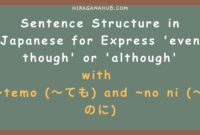Explaining Likes and Dislikes in Japanese
Understanding how to express likes and dislikes is fundamental when learning
the Japanese language. This lesson will guide you through the essential
grammar patterns and provide practical examples to help you communicate your
preferences effectively.
Basic Sentence Structure
The grammar pattern we will focus on is:
Noun 1 + は (wa) + Noun 2 + が (ga) + 好き / 嫌いです (suki / kirai)
desu
This structure allows you to say things like “I like sushi” or “She dislikes
rainy days.”

Example Sentences Expressing Likes
Here are three example sentences that express likes using the
好き (suki) form:
-
わたしはすしがすきです
(watashi wa sushi ga suki desu): I like sushi. -
かれはおんがくがすきです (kare wa ongaku ga suki desu): He likes music.
-
かのじょはねこがすきです
(kanojo wa neko ga suki desu): She likes cats.
Example Sentences Expressing Dislikes
Here are three example sentences that express dislikes using the
嫌い (kirai) form:
(watashi wa karai tabemono ga kirai desu): I dislike spicy food.
Vocabulary List
To enhance your understanding, here is a list of vocabulary used in the
example sentences above:
Likes (好き)
| Kanji | Hiragana | Romaji | Meaning |
|---|---|---|---|
| 私 | わたし | watashi | I/me |
| 寿司 | すし | sushi | sushi |
| 彼 | かれ | kare | he/him |
| 音楽 | おんがく | ongaku | music |
| 彼女 | かのじょ | kanojo | she/her |
| 猫 | ねこ | neko | cat |
Dislikes (嫌い)
| Kanji | Hiragana | Romaji | Meaning |
|---|---|---|---|
| 辛い | からい | karai | spicy |
| 食べ物 | たべもの | tabemono | food |
| 早起き | はやおき | hayaoki | waking up early |
| 雨 | あめ | ame | rain |
Tips for Learning to Express Likes and Dislikes
-
Expand Your Vocabulary: The more words you know, the easier
it will be to express your preferences. Use free resources and language
learning apps to build your vocabulary. -
Practice Regularly: Consistent practice helps reinforce the
grammar patterns and vocabulary. Try writing your own sentences or speaking
them aloud. -
Engage with Native Speakers: Joining virtual classes or
language exchange programs can provide practical experience in using these
expressions naturally.
Applying What You’ve Learned
To effectively use the grammar pattern
Noun 1 + は + Noun 2 + が + 好き / 嫌いです, try creating
your own sentences. For example:
-
ともだちはえいががすきです
(tomodachi wa eiga ga suki desu): Friends like movies. -
おとうとはやきゅうがきらいです
(otouto wa yakyuu ga kirai desu): My younger brother dislikes baseball.
Common Mistakes to Avoid
-
Incorrect Particle Usage: Ensure you use
が (ga) after the second noun, not
は (wa). -
Adjective Agreement: Remember to match the form of
好き (suki) and
嫌い (kirai) appropriately. -
Word Order: Maintain the correct order:
Noun 1 + は + Noun 2 + が + 好き / 嫌いです.
Additional Resources
-
Free Online Courses: Many platforms offer free Japanese
lessons that cover expressing likes and dislikes. Websites like Duolingo and
Memrise provide interactive lessons to reinforce your learning. -
Language Learning Apps: Utilize apps to practice vocabulary
and grammar on the go. They often include exercises that make learning
engaging and effective. -
Virtual Classes: Joining an online class can offer
structured learning and opportunities to practice with instructors and
peers.
Explaining likes and dislikes in Japanese using the pattern
Noun 1 + は + Noun 2 + が + 好き / 嫌いです is an essential
skill for everyday conversations. By practicing the provided examples and
expanding your vocabulary, you’ll be able to express your preferences clearly
and confidently. Remember to utilize free resources and consistent practice to
enhance your language learning journey.
Happy learning, and enjoy your path to mastering the Japanese language!


